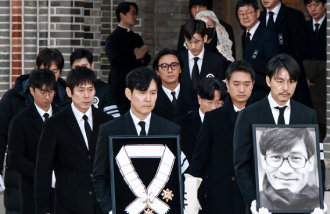Special exhibition on Jeju Uprising opens at national museum
Special exhibition on Jeju Uprising opens at national museum
Posted March. 30, 2018 08:02,
Updated March. 30, 2018 08:02

It was April 3, 1948 when a cruel fate befell a 14-year-old girl named Kim In-geun. Her mother, sister-in-law and sister were all shot to death in rice paddies by a group of young men wearing armbands. Her father was also killed in a nearby reservoir. Villagers were decimated. The reservoir water turned red. In 2008, Kim In-geun was finally able to recount her story to an art therapist, 60 years after the terrible incident happened.
At the entrance to a special exhibition room on the third floor of the National Museum of Korean Contemporary History in Jongno-gu, Seoul, are displayed the paintings and writings that Kim produced during her therapy sessions. The meandering lines of her paintings are a stark reminder of the vicissitudes of Korea’s tragic modern history.
The National Museum of Korea is holding a special exhibition titled “Jeju Uprising, Now Part of Our History” to mark the 70th anniversary of the Jeju Uprising on April 3. Seventy years ago, armed insurgents of the South Korean Labor Party’s Jeju branch staged an uprising on April 3, 1948, and a countless number of people were killed in armed conflicts and crackdowns on the island until Sept. 21, 1954. According to the data released by the Ministry of Interior and Safety last year, 10,890 people lost their lives, and as many as 4,046 went missing. It is the second largest number of victims in Korea’s modern history, following that of the Korean War.
For the first time, the special exhibition will disclose the original copy of martial law declaration signed by Rhee Syng-man, the first president of South Korea. Back then, martial law was considered to grant absolute authority to military, resulting in a massacre of countless innocents. In addition, a total of nine documents on the Jeju Uprising held by the National Archive of Korea, including an inmate profile document at Masan Prison, will be brought to light for the first time.
“The Jeju Uprising still remains a scar and a painful history for the people of Jeju,” said Joo Jin-oh, the president of the National Museum of Korean Contemporary History. “We prepared the exhibition in the hopes of contributing to helping them reconcile with and recover from the memories.”
Won-Mo Yu onemore@donga.com







